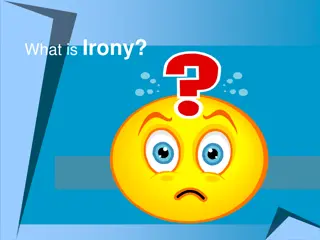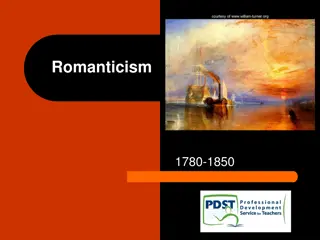Exploring E.T.A. Hoffmann's "The Sandman": A Study in Romanticism, Irony, and the Uncanny
Delve into the world of E.T.A. Hoffmann's literary masterpiece "The Sandman," where themes of Romanticism versus rationality, irony, and the uncanny intertwine. Through the characters of Nathaniel and Clara, the story explores the tensions between passion and reason, imagination and reality. Dive deep into the symbolic significance of automata, the satirical elements in Nathaniel's obsession with Olympia, and the unsettling exploration of the uncanny that has captivated readers for centuries.
Uploaded on Jul 17, 2024 | 0 Views
Download Presentation

Please find below an Image/Link to download the presentation.
The content on the website is provided AS IS for your information and personal use only. It may not be sold, licensed, or shared on other websites without obtaining consent from the author. Download presentation by click this link. If you encounter any issues during the download, it is possible that the publisher has removed the file from their server.
E N D
Presentation Transcript
The Sandman, by E.T.A. Hoffmann Romance VS Rationality; Irony; The Uncanny
E.T.A. Hoffmann, 1776- 1822 Although not all his critics have agreed on the quality of his art, it is clear that Hoffmann was both influenced by and was influential within German Romanticism. A law officer, attorney, then judge by trade, Hoffmann was also a musician/composer and a painter as well as a writer. He is a great example of the Romantic artist, dedicated to the imagination, the supernatural, and the benefits of chaotic confusion. An early exemplar of the fantastic in literature, his writing is known for combining the uncanny with the ironic. Hoffmann s work is perhaps best known for its influence on Wagner and Offenbach, who both wrote operas based on his stories. Even Tchaikovsky s The Nutcracker is based on a Hoffmann tale. For a brief biography of Hoffmann: https://www.britannica.com/biography/E-T-A- Hoffmann
Automata Examples of 19thC. automata Automata are self word is Homeric. Automata are recorded in Ancient Greece and in China as far back as the 5th century B.C.E. self- -operating machines. operating machines. The origin of the In 19th century Europe automata were very popular, and Germans were known around the world for their mechanical toys and cuckoo clocks, among other examples. Hoffmann was known to have been fascinated with automata.
Romantic vs. Rational Nathaniel is the classic romantic: passionate, imaginative, superstitious, and obsessed with expressing his inner states through his art. Clara (as her name suggests) is rational: clarity as opposed to Nathaniel s confusion. She tells Nathaniel to Be convinced that these strange fears have no power over you, and that it is only a belief in their hostile influence that can make them hostile in reality (5). When Nathaniel reads his overwrought poetry to Clara, the following dialogue ensues: 'Nathaniel, dearest Nathaniel, do throw that mad, senseless, insane stuff into the fire!' Upon this Nathaniel sprang up enraged and, thrusting Clara from him, cried: 'Oh, inanimate, accursed automaton! (9).
Irony It is undoubtedly true that Nathaniel s obsession with Olympia is satirical. He sees and hears himself and his passions in what he imagines are Olympia s responses to him. Her rapt attention is compared with that of women (like Clara) who only pretend to listen while knitting or reading, etc. Those around Nathaniel see his obsession as laughable, and so do readers. Is this a questioning of gender roles and a broad hint that, for a man like Nathaniel, an intelligent partner is much less satisfactory than a beautiful doll upon whom he may project his fantasies? Or is this (as some have read it) satirizing those whose rationality renders them inert insofar as imagination and emotion are concerned? Is Olympia merely a perfected model of Clara?
The Sandman: an uncanny story This story, written in 1816, is such a perfect example of the uncanny in literature that it formed the basis for Sigmund Freud s essay on the uncanny (1919), an essay that has itself become the basis for most definitions and discussions of the uncanny. Freud s essay was partly a comment on Ernst Jentsch s earlier examination of the uncanny (1906), which was also written around a discussion of The Sandman. The narrator tells us that the form of the story itself is meant to convey the sense of the uncanny: Thus was I forcibly compelled to tell you of the momentous life of Nathaniel. The marvelous singularity of the story filled my entire soul, but for that very reason and because, my dear reader, I had to make you equally inclined to accept the uncanny, which is no small matter, I was puzzled how to begin Nathaniel's story in a manner as inspiring, original and striking as possible.
Uncanny: The return of the repressed In the first place, if psychoanalytic theory is correct in maintaining that every emotional affect, whatever its quality, is transformed by repression into morbid anxiety, then among such cases of anxiety there must be a class in which the anxiety can be shown to come from something repressed which recurs. This class of morbid anxiety would then be no other than what is uncanny, irrespective of whether it originally aroused dread or some other affect. In the second place, if this is indeed the secret nature of the uncanny, we can understand why the usage of speech has extended das Heimliche into its opposite das Unheimliche;18 for this uncanny is in reality nothing new or foreign, but something familiar and old established in the mind that has been estranged only by the process of repression. This reference to the factor of repression enables us, furthermore, to understand Schelling s definition of the uncanny as something which ought to have been kept concealed but which has nevertheless come to light. (Freud 13) For Nathaniel what was in the past has come to haunt the present, and childhood trauma manifests in doubles, the proliferation of eyes, and the blurring of the human and inhuman.
Uncanny: Reality and imagination There are numerous ways in which the uncanny is made manifest in the story, and in which the story itself is uncanny. Freud states that an uncanny effect is often and easily produced by effacing the distinction between imagination and reality, such as when something that we have hitherto regarded as imaginary appears before us in reality, or when a symbol takes over the full functions and significanc of the thing it symbolizes, and so on. ( The Uncanny 9) The Sandman tells of two such experiences in the life of Nathaniel: the altercation with Coppelius and his confusion of the automaton with a real woman. About the first, Clara tells Nathaniel that it is only in his mind. About the second, the other students can see that Nathaniel is infatuated with a wooden doll. In addition to Nathaniel s confusion, the reader also experiences an unsettling inability to determine what is real in the story and what is imaginary or even supernatural. So the story is about uncanny experience (hence the use of the word several times) but it also fosters an experience of the uncanny in the reader.
Uncanny: The Double Freud (referring to Otto Rank): For the double was originally an insurance against destruction to the ego, an energetic denial of the power of death, as Rank says; and probably the immortal soul was the first double of the body [ ] Such ideas, however, have sprung from the soil of unbounded self-love, from the primary narcissism which holds sway in the mind of the child as in that of primitive man; and when this stage has been left behind the double takes on a different aspect. From having been an assurance of immortality, he becomes the ghastly harbinger of death. Freud and many others have noted Hoffmann s use of the doubling of characters in The Sandman . Nathaniel s father and Coppelius with Spalanzani and Coppola; Lothaire with Sigismund; Clara with Olympia.
Uncanny: Eyes Uncanny: Eyes While we may question Freud s reading of the story (indeed, he even suggests that many will have doubts), for him the motif of eyes, including glasses and telescopes, is related to the fear of castration. The fear of removal of the eyes, he says (using evidence from his psychoanalysis of patients) is a fear of castration. The telescope, it would seem, is a phallic object that allows Nathaniel to penetrate (instantly) into the private room in which Olympia sits, and it is through the telescope that he develops his infatuation with her. Certainly the association of the frightening Coppelius/Coppola with eyes and the Sandman legend suggests that the eyes are a site of vulnerability. Eyes make the self porous, open to invasion, or to a de-humanizing removal of subjectivity. If the eyes are removed, consciousness can no longer look out upon the world and the Other. (Sleep, automata, eyelessness)
Uncanny: What is human? Just as Olympia, the beautiful woman who is in fact a mechanical doll, an object that confuses the viewer s (and the reader s, at first) definition of what is human, the protagonist himself creates a similar confusion in the reader. Although momentary, the confusing moment when Coppelius seizes the child Nathaniel stays in the mind after it is passed over, evoking an uncertainty that colours the whole story: And then he seized me so roughly that my joints cracked, and screwed off my hands and feet, afterwards putting them back again, one after the other. 'There's something wrong here,' he mumbled. 'But now it's as good as ever. The old man has caught the idea!' hissed and lisped Coppelius. (3) Is Nathaniel really an automaton who thinks he is human? The suggestion, which is never revisited explicitly, provokes that strange effect of effacing boundaries between what is real and what is imagined (or artificial). (Note: The Sandman influenced Philip K. Dick s story Do Androids Dream of Electric Sheep? on which the film Blade Runner was based. In that story and film, too, uncertainty about who is human and who is a replicant leads to philosophical questioning of what makes us human-- the central question that informs much of the discomfort around AI.)
Questions for further thought Do you see any similarities between the personalities of Nathaniel and Victor Frankenstein? If you re interested, here is an article speculating on a possible relationship between the two texts: https://iamthewalrus2017.wordpress.com/2017/12/01/gothic-masterpiece-the- sandman-by-e-t-a-hoffman/ How does the uncanny (and Freud s theory) help us to understand AI our creation of it and our responses to it? (Here I am thinking of how both Frankenstein and The Sandman suggest a connection between the past, loss, trauma, and obsessive preoccupation with figures that blur the line between life and death.) In both Frankenstein and The Sandman there is a fraught relationship between Enlightenment rationality and Romantic emotional and imaginative excess. How might AI (or at least the debates around its use) be interpreted as an effect of these philosophical movements and their influence on (western) thought? Olympia has much in common with figures of general AI ( robots ) in Sci-fi and early experimental real-life forms, such as Sophia and Japanese proto-AI robots. What can we gather from the fact that the first place our imagination goes when we think of general AI is to living dolls or Fembots ? Do we, like Nathaniel, need to project our ego onto a malleable female presence? Is the creation of AI an extension of a narcissitic need for control?























